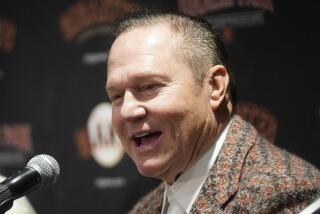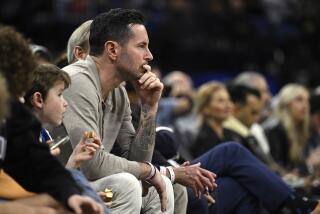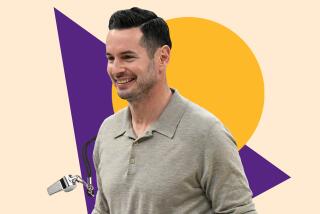Sports agents sometimes have a balancing act with clients
Take the list of coaching clients of a sports agent, and there’s a good chance that it could be mapped like a family tree.
At the top branches, successful coaches such as Pete Carroll, and below them, several of that person’s current and former assistants usually follow. In Carroll’s case, that includes Lane Kiffin, Steve Sarkisian, Ed Orgeron and Sammy Knight.
The tight setup meant that as Orgeron fought for a permanent coaching job at USC in November, his agent, Gary Uberstine, was also helping fellow client Sarkisian through the vetting process for the same gig.
Similar situations arise a few times every year when an agent has multiple clients vying for a single coaching or playing position. The entanglements expose the deep clientele of a select few agents and their ability to leverage those connections to steer some of their talent to a team.
But several agents said fans who think one client might be getting unfairly pitched at the expense of a more favored client are overestimating the influence of agents in hiring decisions and underestimating the sophistication of coaches and players.
“If a conflict develops at some point, you have a discussion about it,” Uberstine said. “More often than not, they have a longstanding relationship and the client values that and believes the agent can represent them in an appropriate manner.”
USC athletics officials and Uberstine declined to specifically discuss the recent hiring of Sarkisian, which prompted Orgeron’s resignation.
“Our rule of thumb is to treat each person’s business as entirely their business, and not let one’s impact the other’s,” Uberstine said.
Uberstine had been through this before. Kiffin and Sarkisian competed for the Oakland Raiders’ coaching job in 2007. Sarkisian dropped out, leaving Kiffin to accept it.
When Kiffin moved to the University of Tennessee after being fired by the Raiders, he switched to agent Jimmy Sexton, who has strong connections in the Southeast and counts among his clients South Carolina Coach Steve Spurrier and Alabama Coach Nick Saban. Kiffin, whose reputation can use some rehabilitation, was recently invited to Alabama for an idea session.
Sandy Montag, who represents several coaches as IMG’s head of clients, said a well-connected agent typically gives clients an advantage.
“Most clients would rather be with an agent that can put them in that position to get hired because another agent might not be able get that ear of the athletic director, general manager or TV network,” Montag said.
Alluding to the USC situation, NFL agent Bob Lattinville said one client may be made aware earlier that he’ll be replaced if he loses a big game to a crosstown rival. Or one client might be able to adjust expectations after an agent relays inside information on how a rival did in his interview.
“Clients are saying, ‘Don’t just stroke my ego, give me information that’s timely and useful,’ ” said Lattinville, who briefly worked at the same firm as Uberstine. “The access to information possible from a broad client pool far outweighs any perception of conflict of interest.”
Uberstine, who has been an agent for more than 25 years, met Carroll through a former colleague just before Carroll joined the New York Jets in 1990. The two have grown close, and Uberstine, who works in Encino, is among the advisors for Carroll’s charity, Win Forever. When it looked as if some of Carroll’s assistants at USC might be in line for head coaching jobs, Uberstine came recommended.
The UCLA graduate’s USC connection has helped him land several USC football alums as clients, including former NFL wide receiver Curtis Conway and Cleveland Browns tight end Jordan Cameron. Representing many players inevitably leads to conflicts, too. In one case, USC alum David Buehler and Sherman Oaks Notre Dame graduate Nick Folk, both Uberstine clients, became friends while competing for the Dallas Cowboys kicking job.
Lattinville said he has never received a call from a general manager asking which of two clients at the same position the team should sign. An agent is just asked to fill in blanks, such as injury history, a location preference or a contract value target.
“Most of the time when you speak to a GM, he already has an opinion about who he wants,” Lattinville said. “You can be persuasive, but more or less, it doesn’t make a difference.”
ESPN analyst and former Raiders cornerback Eric Allen signed with Uberstine in 1989 after asking former USC and NFL cornerback Ronnie Lott who his agent was. Allen knew he’d be up for jobs against other Uberstine defensive backs.
“You know he’s going to bat for you and not going to downplay someone else in a meeting with a general manager,” Allen said. “He’s going to say that it’s going to benefit the organization to have both of these guys.”
Still, some in the industry, while declining to provide specific examples on the record, said they’ve seen agents throw one client under the bus to nudge another inside. A revolving door of firing and hiring can be lucrative for an agent, who collects fees from both parties.
“That’s a pretty dastardly way of running your business, but to think it doesn’t happen is wrong,” said NBA player agent Keith Glass.
Frustration can also arise when someone in charge plays favorite with an agent or when an agent pressures a head coach or general manager to sign more of that agent’s clients as assistants or roster fillers.
“I would like to think guys hire the best guy for the job, regardless of who the agent is, but I know that doesn’t always happen,” said P.J. Carlesimo, an ESPN basketball analyst and former NBA coach. “It’s totally within their right. They might even say it makes sense to have those good relationships.”
In the NFL, six agents represent at least 17 of the 32 head coaches with Sexton, Reno-based Bob LaMonte and Irvine-based David Dunn topping the list. The situation’s tighter in the NBA. Three agents — Atlanta-based Lonnie Cooper, San Francisco-based Warren LeGarie and Los Angeles-based Steve Kauffman — represent at least 19 of the 30 coaches. Some of them also represent general managers. LeGarie, for example, has Portland Trail Blazers General Manager Neil Olshey, Coach Terry Stotts and the interim coach before him, Kaleb Canales.
Kauffman now represents coaches and executives exclusively, saying that true conflicts occur when representing a coach and a player on the same team. Arguing that a player should get more playing time while the coach might be feeling pressure to bench him can become dicey, he suggested.
“It just doesn’t pass our smell test,” Kauffman said.
Uberstine said the trick is to let everyone know up front about potential relationships. For example, Carroll and Seahawks wide receiver Jermaine Kearse are Uberstine clients.
“I think [Carroll] understands when I’m representing players, I’m doing what I can think best represents that player’s interests,” Uberstine said. “Likewise, if he cuts one of my players, I don’t take it personally.”
Kauffman did agree that representing coaches going for the same position is less of a conflict. Teams have their own evaluation system, and the agent’s role is capped at helping set a salary target and handing over a PowerPoint with testimonials and a resume. Kauffman’s clients at the time, Mark Jackson and Mike Malone, finished one-two out of seven finalists to become the Golden State Warriors’ coach in 2011.
Kauffman first called Jackson, the winner. Jackson immediately asked Kauffman to get Malone on board as lead assistant.
Malone refused the associate head coach title, saying he didn’t want to make it look as if he were waiting in the wings to replace his friend, Jackson, a rookie on the job.
“It’s amazing, the fraternity and how much they care about each other,” Kauffman said. “We screen so selectively that conflict comes up less than you would think.”
Jackson reportedly later switched to his agent as a player, Arn Tellem, when Jackson realized nothing precluded him from having an advisor who also represented players — more than 40 of them, including the Warriors’ Jermaine O’Neal. Through a Warriors spokesman, Jackson said he now represents himself.
Twitter: @peard33
More to Read
Go beyond the scoreboard
Get the latest on L.A.'s teams in the daily Sports Report newsletter.
You may occasionally receive promotional content from the Los Angeles Times.











